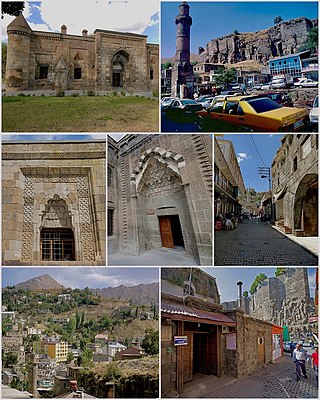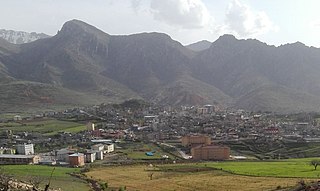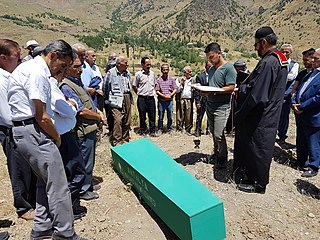
Diyarbakır, formerly Diyarbekir, is the largest Kurdish-majority city in Turkey. It is the administrative center of Diyarbakır Province.

The Sayfo, also known as the Seyfo or the Assyrian genocide, was the mass murder and deportation of Assyrian/Syriac Christians in southeastern Anatolia and Persia's Azerbaijan province by Ottoman forces and some Kurdish tribes during World War I.

Bitlis is a city in southeastern Turkey. It is the seat of Bitlis District and Bitlis Province. Its population is 53,023 (2021). The city is located at an elevation of 1,545 metres, 15 km from Lake Van, in the steep-sided valley of the Bitlis River, a tributary of the Tigris. The local economy is mainly based on agricultural products which include fruits, grain and tobacco. Industry is fairly limited, and deals mainly with leatherworking, manufacture of tobacco products as well as weaving and dyeing of coarse cloth. Bitlis is connected to other urban centres by road, including Tatvan on Lake Van, 25 km to the northeast, and the cities of Muş (Mush), 100 km northwest, and Diyarbakır, 200 km to the west. The climate of Bitlis can be harsh, with long winters and heavy snowfalls. Since the local elections of March 2019, the Mayor of Bitlis is Nesrullah Tanğlay.

Mardin is a city and seat of the Artuklu District of Mardin Province in Turkey. It is known for the Artuqid architecture of its old city, and for its strategic location on a rocky hill near the Tigris River.

Elazığ is a city in the Eastern Anatolia region of Turkey, and the administrative centre of Elazığ Province and Elazığ District. Founded in and around the former city of Harput, it is located in the uppermost Euphrates valley. The plain on which the city extends has an altitude of 1,067 metres (3,501 ft). Elazığ resembles an inland peninsula surrounded by the natural Lake Hazar and reservoirs of Keban Dam, Karakaya Dam, Kıralkızı and Özlüce. Its population is 387,072 (2022).
Hertevin, officially Ekindüzü, is a village in the Pervari District of Siirt Province in Turkey.

Eruh is a town and seat of Eruh District of Siirt Province of Turkey.

Kızıltepe is a municipality and district of Mardin Province, Turkey. Its area is 1,236 km2, and its population is 267,151 (2022). It is mainly populated by Kurds of the Kîkan Kurdish tribe.
Kurtalan is a municipality in the Kurtalan District of Siirt Province in Turkey. It was called Garzan until 1938 when it was renamed. The municipality is populated by Kurds of the Pencenarî tribe and had a population of 36,273 in 2021.

Midyat is a municipality and district of Mardin Province, Turkey. Its area is 1,241 km2, and its population is 120,069 (2022).
Şirvan is a municipality in the Şirvan District of Siirt Province in southeastern Turkey. It is populated by Kurds of the Silokan and Sturkiyan tribes and had a population of 3,958 in 2021.

Assyrians in Turkey or Turkish Assyrians are the indigenous Semitic-speaking ethnic group and an oppressed minority of Turkey, who are Eastern Aramaic–speaking Christians, with most being members of the Syriac Orthodox Church, Chaldean Catholic Church, Assyrian Pentecostal Church, Assyrian Evangelical Church, or Ancient Church of the East.

The vast majority of Christians in Iraq are indigenous Assyrians who descend from ancient Assyria, and are considered to be one of the oldest continuous Christian communities in the world. They primarily adhere to the Syriac Christian tradition and rites and speak Northeastern Neo-Aramaic dialects, although Turoyo is also present on a smaller scale. Some are also known by the name of their religious denomination as well as their ethnic identity, such as Chaldo-Assyrians, Chaldean Catholics or Syriacs. Non-Assyrian Iraqi Christians include Arab Christians and Armenians, and a very small minority of Kurdish, Shabaks and Iraqi Turkmen Christians. Regardless of religious affiliation Assyrians Christians in Iraq and surrounding countries are one genetically homogeneous people and are of different origins than other groups in the country, with a distinct history of their own harking back to ancient Assyria and Mesopotamia.

Addai Scher Also written Addai Sher, Addaï Scher and Addai Sheir, an ethnic Assyrian, was the Chaldean Catholic archbishop of Siirt in Upper Mesopotamia. He was killed by the Ottomans during the 1915 Assyrian Genocide.
Massacres of Diyarbakır were massacres that took place in the Diyarbekir Vilayet of the Ottoman Empire between the years of 1894 and 1896 by Muslims, a majority of whom were ethnic Kurds. The events were part of the Hamidian massacres and targeted the vilayet's Christian population – mostly Armenians and Assyrians.

The Defence of Iwardo was a military engagement between Ottoman authorities and Assyrian defenders led by Gallo Shabo in 1915, during the Assyrian genocide. The pockets of resistance during the Assyrian genocide was named "Midyat Rebellion" after Midyat, the largest Assyrian town in Tur Abdin by the Ottoman authorities.

Öğündük is a village in the İdil District of Şırnak Province in Turkey. The village is populated by Assyrians and had a population of 367 in 2021. It is located in the historic region of Tur Abdin.
Başakköy is a village in the İdil District of Şırnak Province in Turkey. The village is populated by Kurds of the Domanan tribe and had a population of 124 in 2021. It is located in the historic region of Tur Abdin.
Bardakçı is a neighbourhood in the municipality and district of Midyat, Mardin Province in Turkey. The village is populated by Assyrians and by Kurds of the Arnas tribe and had a population of 164 in 2021. It is located in the historic region of Tur Abdin.
Ortaca is a neighbourhood in the municipality and district of Midyat, Mardin Province in Turkey. The village is populated by Assyrians and by Kurds of the Elîkan tribe and had a population of 747 in 2021. It is located in the historic region of Tur Abdin.


























